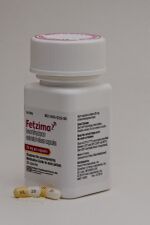Chemistry:Levomilnacipran
 | |
| Clinical data | |
|---|---|
| Trade names | Fetzima |
| AHFS/Drugs.com | Monograph |
| Routes of administration | By mouth (capsules) |
| ATC code | |
| Legal status | |
| Legal status |
|
| Pharmacokinetic data | |
| Bioavailability | 92%[1] |
| Protein binding | 22%[2] |
| Metabolism | Hepatic (primarily by CYP3A4)[3] |
| Elimination half-life | 12 hours[3] |
| Excretion | Kidney[3] |
| Identifiers | |
| |
| CAS Number |
|
| PubChem CID | |
| IUPHAR/BPS | |
| DrugBank | |
| ChemSpider | |
| UNII |
|
| KEGG | |
| Chemical and physical data | |
| Formula | C15H22N2O |
| Molar mass | 246.354 g·mol−1 |
| 3D model (JSmol) | |
| |
| |
| | |
Levomilnacipran (brand name Fetzima) is an antidepressant which was approved in the United States in 2013 for the treatment of major depressive disorder (MDD) in adults.[1] It is the levorotatory enantiomer of milnacipran, and has similar effects and pharmacology, acting as a serotonin–norepinephrine reuptake inhibitor (SNRI).[4][5]
Medical uses
Depression
The FDA approved levomilnacipran for treating major depressive disorder. This approval was based on the results of five clinical trials. The trials included one 10-week phase II and four 8-week phase III. Four of the five trials demonstrated a statistically significant superiority to placebo as measured by the Montgomery–Åsberg Depression Rating Scale. Superiority to placebo was also demonstrated by improvement in the Sheehan Disability Scale.
Side effects
Side effects seen more often with levomilnacipran than with placebo in clinical trials included nausea, dizziness, sweating, constipation, insomnia, increased heart rate and blood pressure, urinary hesitancy, erectile dysfunction and delayed ejaculation in males, vomiting, tachycardia, and palpitations.[6][7]
Pharmacology
Pharmacodynamics
Relative to other SNRIs, levomilnacipran, as well as milnacipran, differ in that they are much more balanced reuptake inhibitors of serotonin and norepinephrine.[8][9][10] To demonstrate, the serotonin:norepinephrine ratios of SNRIs are as follows: venlafaxine = 30:1, duloxetine = 10:1, desvenlafaxine = 14:1, milnacipran = 1.6:1, and levomilnacipran = 1:2.[8] The clinical implications of more balanced elevations of serotonin and norepinephrine are unclear,[8] but may include improved effectiveness, though also increased side effects.[9][10][11]
Levomilnacipran is selective for the serotonin and norepinephrine transporters, lacking significant affinity for over 23 off-target sites.[12] However, it does show some affinity for the dizocilpine (MK-801/PCP) site of the NMDA receptor (Ki = 1.7 μM), and has been found to inhibit NR2A and NR2B subunit-containing NMDA receptors with respective IC50 values of 5.62 and 4.57 μM.[12] As such, levomilnacipran is an NMDA receptor antagonist at high concentrations.[12]
Levomilnacipran has recently been found to act as an inhibitor of beta-site amyloid precursor protein cleaving enzyme-1 (BACE-1), which is responsible for β-amyloid plaque formation, and hence may be a potentially useful drug in the treatment of Alzheimer's disease.[13]
Pharmacokinetics
Levomilnacipran has a high oral bioavailability of 92% and a low plasma protein binding of 22%.[1][2] It is metabolized in the liver by the cytochrome P450 enzyme CYP3A4,[3] thereby making the medication susceptible to grapefruit-drug interactions. The drug has an elimination half-life of approximately 12 hours, allowing for once-daily administration.[3] Levomilnacipran is excreted in urine.[3]
History
Levomilnacipran was developed by Forest Laboratories and Pierre Fabre Group, and was approved by the Food and Drug Administration in July 2013.[6]
References
- ↑ 1.0 1.1 1.2 "Fetzima (levomilnacipran) Extended-Release Capsules, for Oral Use. Full Prescribing Information". Forest Pharmaceuticals, Inc. Subsidiary of Forest Laboratories, Inc. St. Louis, MO 63045 USA. July 2014. http://www.allergan.com/assets/pdf/fetzima_pi#page=1.
- ↑ 2.0 2.1 "Duloxetine, Milnacipran, and Levomilnacipran". The American Psychiatric Association Publishing Textbook of Psychopharmacology. American Psychiatric Pub. 10 May 2017. pp. 533–. ISBN 978-1-61537-122-8. https://books.google.com/books?id=v9wnDwAAQBAJ&pg=PA533.
- ↑ 3.0 3.1 3.2 3.3 3.4 3.5 Prescriber's Guide: Stahl's Essential Psychopharmacology. Cambridge University Press. 31 March 2017. pp. 373–376. ISBN 978-1-108-22874-9. https://books.google.com/books?id=9hssDwAAQBAJ&pg=PA373.
- ↑ "Pierre Fabre Medicament and Forest Laboratories to Collaborate on Development and Commercialization of F2695 for Depression". FierceBiotech. 22 December 2008. http://www.fiercebiotech.com/press-releases/pierre-fabre-medicament-and-forest-laboratories-collaborate-development-and-commerc-0.
- ↑ "Which bioequivalence study for a racemic drug? Application to milnacipran". European Journal of Drug Metabolism and Pharmacokinetics 23 (2): 166–171. 1998. doi:10.1007/bf03189334. PMID 9725476.
- ↑ 6.0 6.1 "Levomilnacipran for major depressive disorder: a systematic review of the efficacy and safety profile for this newly approved antidepressant--what is the number needed to treat, number needed to harm and likelihood to be helped or harmed?". International Journal of Clinical Practice 67 (11): 1089–1104. November 2013. doi:10.1111/ijcp.12298. PMID 24016209.
- ↑ "A phase III, double-blind, placebo-controlled, flexible-dose study of levomilnacipran extended-release in patients with major depressive disorder". Journal of Clinical Psychopharmacology 34 (1): 47–56. February 2014. doi:10.1097/JCP.0000000000000060. PMID 24172209.
- ↑ 8.0 8.1 8.2 "Serotonin norepinephrine reuptake inhibitors: a pharmacological comparison". Innovations in Clinical Neuroscience 11 (3–4): 37–42. March 2014. PMID 24800132.
- ↑ 9.0 9.1 "Levomilnacipran (Fetzima): A New Serotonin-Norepinephrine Reuptake Inhibitor for the Treatment of Major Depressive Disorder". Journal of Pharmacy Practice 27 (4): 389–395. August 2014. doi:10.1177/0897190013516504. PMID 24381243.
- ↑ 10.0 10.1 "Milnacipran: a unique antidepressant?". Neuropsychiatric Disease and Treatment 6 (Suppl I): 23–31. September 2010. doi:10.2147/NDT.S11777. PMID 20856597.
- ↑ "Does adding noradrenaline reuptake inhibition to selective serotonin reuptake inhibition improve efficacy in patients with depression? A systematic review of meta-analyses and large randomised pragmatic trials". Journal of Psychopharmacology 27 (8): 740–758. August 2013. doi:10.1177/0269881113494937. PMID 23832963.
- ↑ 12.0 12.1 12.2 "Levomilnacipran extended release: first global approval". Drugs 73 (14): 1639–1645. September 2013. doi:10.1007/s40265-013-0116-1. PMID 24000002.
- ↑ "Fetzima (levomilnacipran), a drug for major depressive disorder as a dual inhibitor for human serotonin transporters and beta-site amyloid precursor protein cleaving enzyme-1". CNS & Neurological Disorders Drug Targets 13 (8): 1427–1431. 2014. doi:10.2174/1871527313666141023145703. PMID 25345508.
External links
- "Levomilnacipran". Drug Information Portal. U.S. National Library of Medicine. https://druginfo.nlm.nih.gov/drugportal/name/levomilnacipran.
 |


